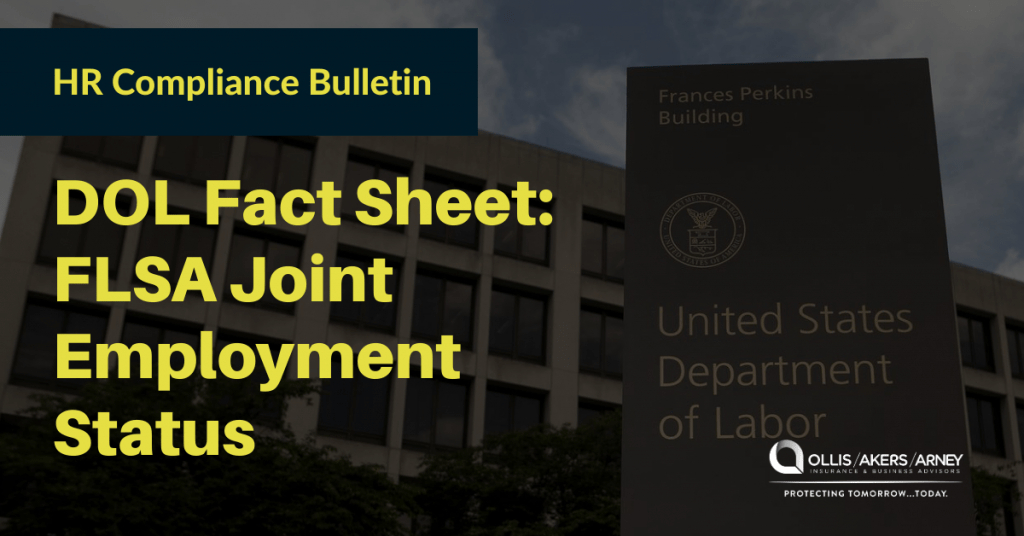The U.S. Department of Labor (DOL) is updating and revising its regulations issued under the Fair Labor Standards Act (FLSA or the Act) that provide guidance on determining joint employer status under the Act.
The FLSA requires covered employers to pay their employees at least the federal minimum wage for every hour worked and overtime for every hour worked over 40 in a workweek. To be liable for paying minimum wage or overtime, an individual or entity must be an “employer,” which the FLSA defines in Section 3(d) to include “any person acting directly or indirectly in the interest of an employer in relation to an employee[.]”
Under the FLSA, an employee may have—in addition to his or her employer—one or more joint employers. A joint employer is any additional “person” (i.e., an individual or entity) who is jointly and severally liable with the employer for the employee’s wages.
Action Steps
The DOL has the authority to enforce full compliance with labor standards against one or all joint employers.
To avoid violations, employers should:
- Become familiar with this final rule;
- Evaluate whether they are in a joint employment situation; and
- Identify any potential areas of non-compliance by joint employers.
Part 791 constitutes the Department’s official interpretation of joint employer status under the FLSA. The final rule continues to recognize two potential scenarios where an employee may have one or more joint employers. In the first scenario, the employee has an employer who suffers, permits, or otherwise employs the employee to work, but another individual or entity simultaneously benefits from that work. In the second scenario, one employer employs an employee for one set of hours in a workweek, and another employer employs the same employee for a separate set of hours in the same workweek. The final rule describes the standards to determine joint employer status in each scenario.
Scenario 1: When Employers Simultaneously Benefit from an Employee’s Work
In the first scenario, where an employee performs work for the employer that simultaneously benefits another individual or entity, the final rule adopts a four-factor balancing test to determine whether the potential joint employer is directly or indirectly controlling the employee, assessing whether the potential joint employer:
- Hires or fires the employee;
- Supervises and controls the employee’s work schedule or conditions of employment to a substantial degree;
- Determines the employee’s rate and method of payment; and
- Maintains the employee’s employment records.
Whether a person is a joint employer will depend on all the facts in a particular case, and the appropriate weight to give each factor will vary depending on the circumstances. However, the potential joint employer’s maintenance of the employee’s employment records alone will not lead to a finding of joint employer status. The final rule notes that additional factors may also be relevant in determining whether another person is a joint employer in this situation, but only when they show whether the potential joint employer is exercising significant control over the terms and conditions of the employee’s work.
The final rule also identifies factors that are not relevant to the determination of FLSA joint employer status. For example, the final rule specifies that whether the employee is economically dependent on the potential joint employer, including factors traditionally used to establish whether a particular worker is a bona fide independent contractor (e.g., the worker’s opportunity for profit or loss, their investment in equipment and materials, etc.), are not relevant to determine joint employer liability. The final rule also identifies certain other factors that do not make joint employer status more or less likely under the Act, including:
- Operating as a franchisor or entering into a brand and supply agreement, or using a similar business model;
- The potential joint employer’s contractual agreements with the employer requiring the employer to comply with its legal obligations or to meet certain standards to protect the health or safety of its employees or the public;
- The potential joint employer’s contractual agreements with the employer requiring quality control standards to ensure the consistent quality of the work product, brand, or business reputation; and
- The potential joint employer’s practice of providing the employer with a sample employee handbook, or other forms, allowing the employer to operate a business on its premises (including “store within a store” arrangements), offering an association health plan or association retirement plan to the employer or participating in such a plan with the employer, jointly participating in an apprenticeship program with the employer, or any other similar business practice.
Scenario 2: Employee Works Separate Set of Hours for Different Employers
The final rule did not make any substantive changes to the standard for determining joint employer liability in the second scenario. If the employers are acting independently of each other and are disassociated with respect to the employment of the employee, each employer may disregard all work performed by the employee for the other employer in determining its liability under the FLSA.
However, if the employers are sufficiently associated with respect to the employment of the employee, they are joint employers and must aggregate the hours worked for each for purposes of determining if they are in compliance. The employers will generally be sufficiently associated if there is an arrangement between them to share the employee’s services, the employer is acting directly or indirectly in the interest of the other employer in relation to the employee, or they share control of the employee, directly or indirectly, by reason of the fact that one employer controls, is controlled by, or is under common control with the other employer.
Additional Guidance
Finally, the final rule provides several examples of how the Department’s joint employer guidance should be applied in various factual circumstances.
The New Test
The final rule requires the DOL to examine whether a potential joint employer:
- Hires or fires the employee;
- Supervises and controls the employee’s work schedule or conditions of employment to a substantial degree;
- Determines the employee’s rate and method of payment; and
- Maintains the employee’s employment records.
However, the rule also clarifies that additional factors may be considered as necessary.
Source: U.S. Department of Labor
Regulatory changes are constantly being released from different agencies. Contact us today and let us help you navigate these updates and ensure that your business is compliant and efficient.






